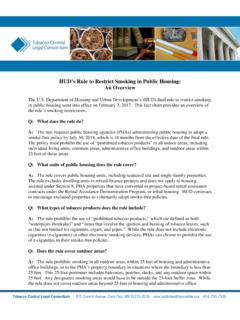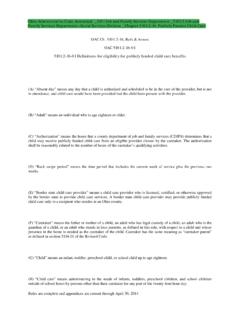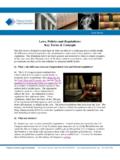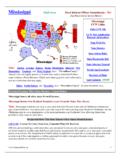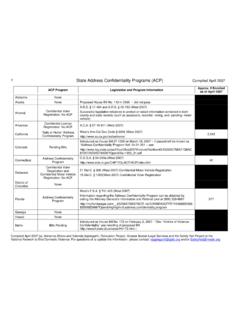Transcription of The Master Settlement Agreement: An Overview
1 The Master Settlement agreement : An Overview / 1. The Master Settlement agreement : An Overview In the 1990s, several states sued the major cigarette manufacturers, including Philip Morris USA, R. J. Reynolds, Brown & Williamson, and Lorillard, to recover Medicaid and other costs the states incurred in treating sick and dying cigarette smokers. On November 23, 1998, the cigarette manufacturers, along with forty-six states and six other jurisdictions (the Settling States ), entered into what is called the Master Settlement agreement (MSA), the largest civil litigation Settlement in history. As outlined in the MSA, each of the Settling States gave up any future legal claims they might have based on the cigarette companies' actions at issue in the settled lawsuits.
2 This did not include the individual claims of their residents. In exchange, the companies signing the MSA (the Participating Manufacturers ). agreed to make annual payments in perpetuity to the Settling States to compensate them for taxpayer money spent for health-care costs connected to tobacco-related illness. The MSA also sets standards, and imposes restrictions on, the sale and marketing of cigarettes by participating cigarette manufacturers, and includes other requirements and restrictions regarding tobacco company conduct. This publication provides answers to several common questions about the MSA. 1 For more information about the MSA, check out the publications and resources on the Public Health Law Center's website or the National Association of Attorneys General's website.
3 Q: What was the focus of the litigation? A: In the mid-1950s through 1994, individuals brought over 800 claims against cigarette manufacturers for damages related to the effects of smoking. 2 However, the manufacturers, raising defenses such as contributory negligence and the individual responsibility of smokers, generally prevailed in these lawsuits. In 1994, a number of states, beginning with Mississippi, 3. sued the largest cigarette manufacturers under a variety of legal theories, including state consumer protection and antitrust laws, arguing that cigarettes contributed to health problems that triggered significant costs to state health-care systems. In 1997, four states (Mississippi, 4.)
4 Minnesota, 5 Florida, and Texas), reached settlements to recover for Medicaid and other health expenses resulting from smoking-caused illnesses. After these settlements, the major manufacturers, facing a growing number of suits by other states, 6 joined with those states and petitioned Congress for a global resolution in June 1997. Congress failed to pass the global Settlement agreement , but the manufacturers and the Settling States were still able to reach a Settlement in November of the following year: the Master Settlement agreement . 7. The Master Settlement agreement : An Overview / 2. Q: Who is party to the MSA? A: The MSA is a private agreement between forty-six states, four territories, the Commonwealth of Puerto Rico, the District of Columbia, and the four largest tobacco manufacturers Philip Morris USA, Reynolds, Brown & Williamson, and Lorillard, known collectively as the Original Participating Manufacturers.
5 (Since the MSA became effective, mergers and acquisitions have left Reynolds as the successor in interest in Brown &. Williamson and Lorillard, leaving two Original Participating Manufacturers remaining.) Several other tobacco companies, known as Subsequent Participating Manufacturers, have also signed the agreement since 1998. (Original and Subsequent Participating Manufacturers are referred to collectively as Participating Manufacturers.) The number of Participating Manufacturers remains fluid as, over the years, some additional manufacturers have signed and others have gone out of business. Since the MSA was signed in November 1998, approximately 40 other cigarette manufacturers have signed the agreement and are bound by its terms.
6 Q: Why did the parties agree to settle? A: According to the first section of the MSA, the parties settled to avoid the further expense, delay, inconvenience, burden and uncertainty of continued litigation (including appeals from any verdicts). 8 The MSA was intended to further the Settling States' policies designed to reduce Youth smoking, to promote public health, and to secure monetary payment to the settling states. 9 The MSA only settles state and local government lawsuits; the tobacco industry gains no protection from class-action lawsuits and claims brought by individuals, labor unions, and private health-care insurers. 10. Q: How much does the MSA require tobacco companies to pay the Settling States?
7 A: Each year, an independent auditor calculates the Settlement payment to be made by each Participating Manufacturer and the amount to be received by each Settling State. 11 If parties disagree with the auditor's calculations, the matter is submitted to binding arbitration by three neutral arbitrators who must be former federal judges. 12 The MSA sets up initial, annual, and strategic contribution payments for states. Initial payments. In addition to annual payments beginning on April 15, 2000, the MSA. required Participating Manufacturers to make upfront payments in each of the first five years after the MSA's execution, or a total of about $ billion, adjusted for the volume of cigarette shipments in those years compared to the volume in 1997.
8 13. Annual payments (made in perpetuity). Just as the Settling States' Medicaid and other health-care costs due to their citizens' smoking-related illnesses will likely continue indefinitely, the MSA provides that the Participating Manufacturers' payments to the Settling States will continue in perpetuity. 14 The base amounts of these annual payments gradually increase, beginning at $ billion in 2000, $ billion from 2002 . The Master Settlement agreement : An Overview / 3. 2003, $ billion from 2008 2017, and $9 billion in 2018 and each subsequent year in perpetuity. 15 Importantly, calculations of annual payments are complex and are subject to a variety of potential adjustments and offsets, including an inflation adjustment and a volume adjustment.
9 16 Most significantly, percentage reductions in cigarette shipment volumes have been greater than inflation adjustments since 1997, so actual annual payments have been lower than those set forth as base amounts in the MSA and can be expected to continue to be. Participating Manufacturers are required to make annual payments based on their shares of national cigarette sales and shipments. In addition, Participating Manufacturers have routinely withheld payments or made them into an escrow account pending resolution of disputes relating to certain of the above-mentioned adjustments. Settling States receive an allocation of these payments based on a percentage set forth in Exhibit A to the MSA.
10 Strategic Contribution Payments. These payments serve as bonus payments for states that invested time and finances into the litigation that led to the MSA. The payments are allocated according to the percentages set forth in Exhibit U to the MSA, which were based on each Settling State's contribution to the litigation or resolution of the state tobacco litigation. 17 The Participating Manufacturers' base Strategic Contribution Payment amount is $861 million each year from 2008 to 2017, 18 subject to the same adjustments as the annual payments. 19. Q: What else does the MSA do? A: The MSA restricts specific cigarette manufacturer conduct, including certain tobacco lobbying, creates a national tobacco control foundation, and dismantles several tobacco industry initiatives: It imposes significant prohibitions and restrictions on tobacco advertising, marketing and promotional programs or activities.




